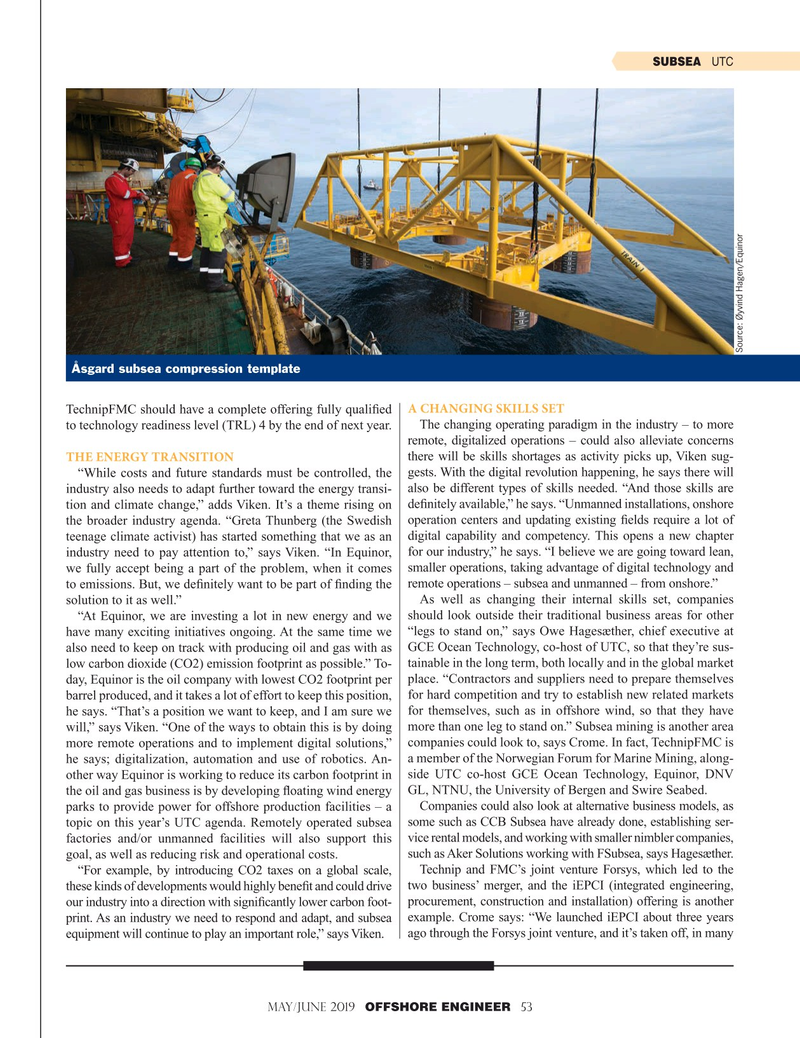
Page 53: of Offshore Engineer Magazine (May/Jun 2019)
Offshore Renewables Review
Read this page in Pdf, Flash or Html5 edition of May/Jun 2019 Offshore Engineer Magazine
SUBSEA UTC
Source: Øyvind Hagen/Equinor
Åsgard subsea compression template
TechnipFMC should have a complete offering fully quali? ed A CHANGING SKILLS SET to technology readiness level (TRL) 4 by the end of next year. The changing operating paradigm in the industry – to more remote, digitalized operations – could also alleviate concerns
THE ENERGY TRANSITION there will be skills shortages as activity picks up, Viken sug- “While costs and future standards must be controlled, the gests. With the digital revolution happening, he says there will industry also needs to adapt further toward the energy transi- also be different types of skills needed. “And those skills are tion and climate change,” adds Viken. It’s a theme rising on de? nitely available,” he says. “Unmanned installations, onshore the broader industry agenda. “Greta Thunberg (the Swedish operation centers and updating existing ? elds require a lot of teenage climate activist) has started something that we as an digital capability and competency. This opens a new chapter industry need to pay attention to,” says Viken. “In Equinor, for our industry,” he says. “I believe we are going toward lean, we fully accept being a part of the problem, when it comes smaller operations, taking advantage of digital technology and to emissions. But, we de? nitely want to be part of ? nding the remote operations – subsea and unmanned – from onshore.” solution to it as well.” As well as changing their internal skills set, companies “At Equinor, we are investing a lot in new energy and we should look outside their traditional business areas for other have many exciting initiatives ongoing. At the same time we “legs to stand on,” says Owe Hagesæther, chief executive at also need to keep on track with producing oil and gas with as GCE Ocean Technology, co-host of UTC, so that they’re sus- low carbon dioxide (CO2) emission footprint as possible.” To- tainable in the long term, both locally and in the global market day, Equinor is the oil company with lowest CO2 footprint per place. “Contractors and suppliers need to prepare themselves barrel produced, and it takes a lot of effort to keep this position, for hard competition and try to establish new related markets he says. “That’s a position we want to keep, and I am sure we for themselves, such as in offshore wind, so that they have will,” says Viken. “One of the ways to obtain this is by doing more than one leg to stand on.” Subsea mining is another area more remote operations and to implement digital solutions,” companies could look to, says Crome. In fact, TechnipFMC is he says; digitalization, automation and use of robotics. An- a member of the Norwegian Forum for Marine Mining, along- other way Equinor is working to reduce its carbon footprint in side UTC co-host GCE Ocean Technology, Equinor, DNV the oil and gas business is by developing ? oating wind energy GL, NTNU, the University of Bergen and Swire Seabed. parks to provide power for offshore production facilities – a Companies could also look at alternative business models, as topic on this year’s UTC agenda. Remotely operated subsea some such as CCB Subsea have already done, establishing ser- factories and/or unmanned facilities will also support this vice rental models, and working with smaller nimbler companies, goal, as well as reducing risk and operational costs. such as Aker Solutions working with FSubsea, says Hagesæther. “For example, by introducing CO2 taxes on a global scale, Technip and FMC’s joint venture Forsys, which led to the these kinds of developments would highly bene? t and could drive two business’ merger, and the iEPCI (integrated engineering, our industry into a direction with signi? cantly lower carbon foot- procurement, construction and installation) offering is another print. As an industry we need to respond and adapt, and subsea example. Crome says: “We launched iEPCI about three years equipment will continue to play an important role,” says Viken. ago through the Forsys joint venture, and it’s taken off, in many
MAY/JUNE 2019 OFFSHORE ENGINEER 53 50-64 OE MayJune 2019.indd 53 6/10/2019 10:27:21 AM

 52
52

 54
54